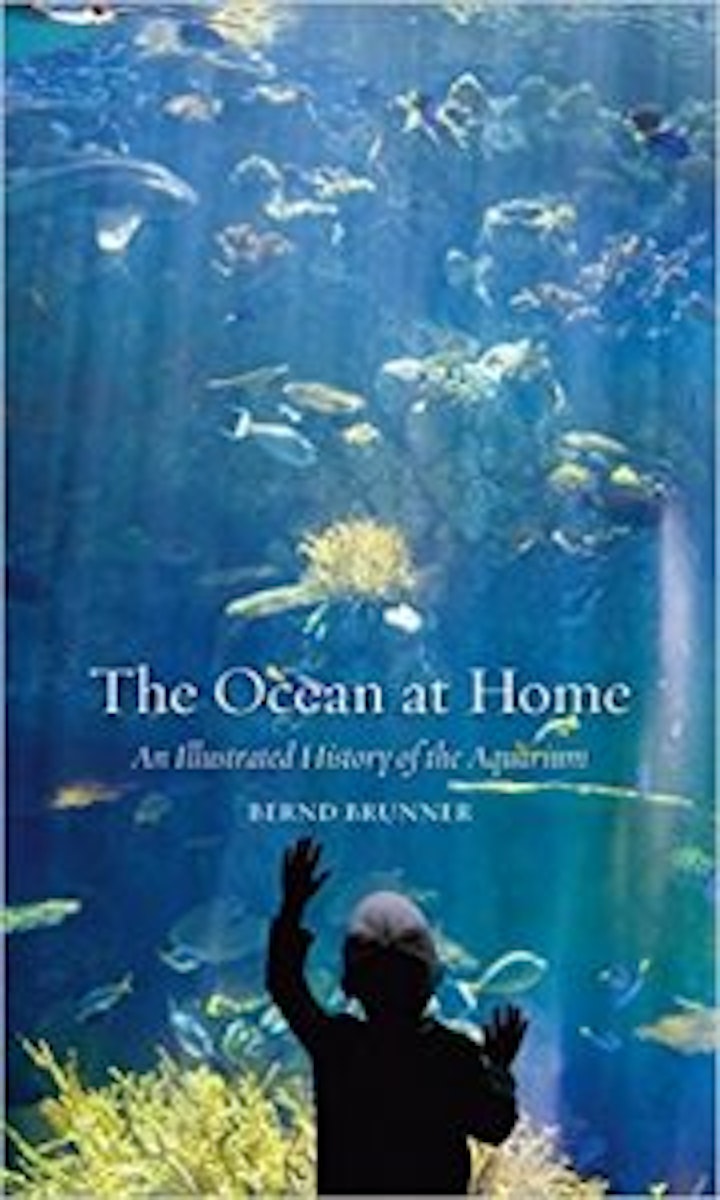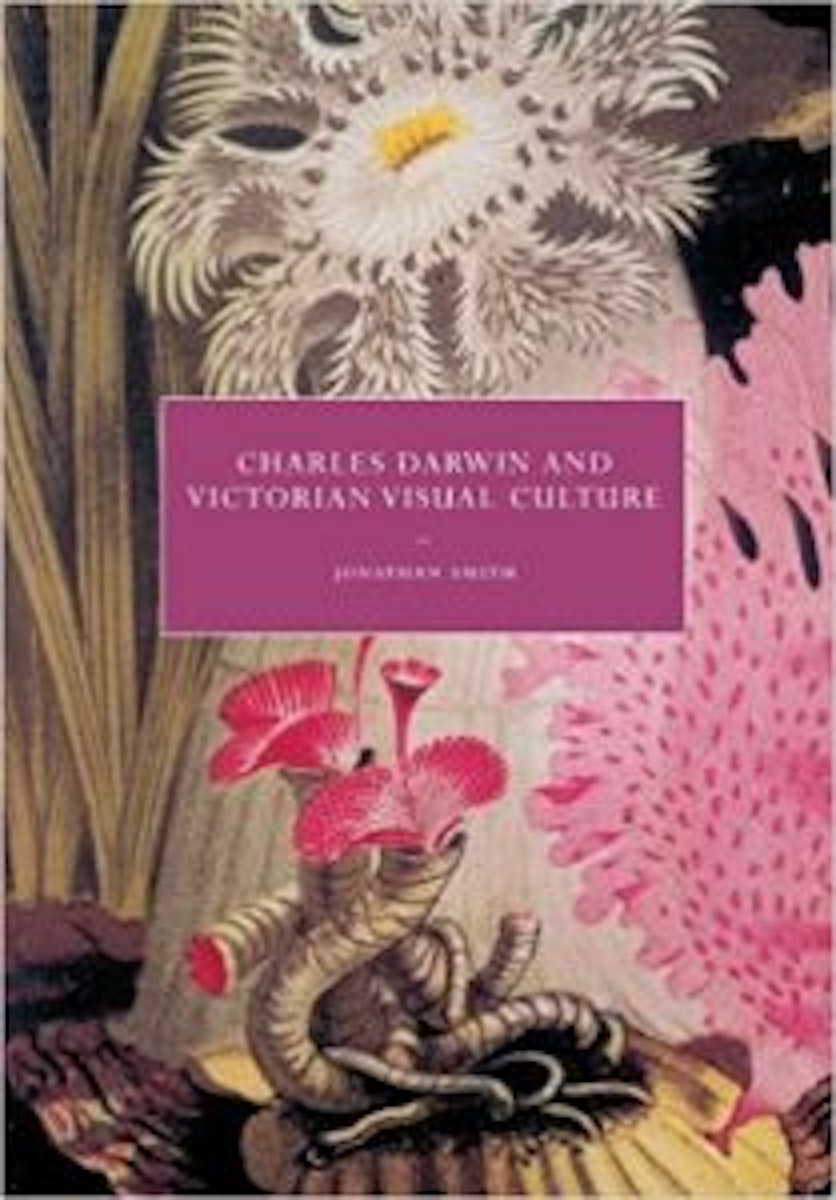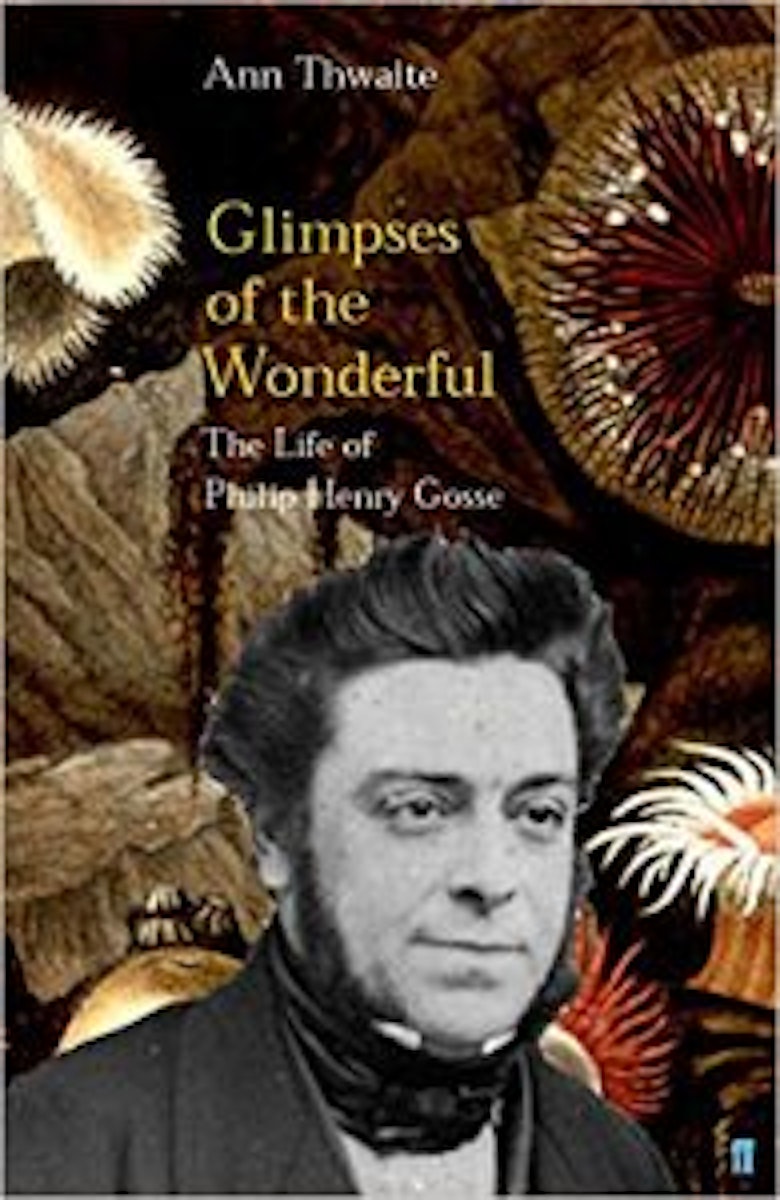
Bringing the Ocean Home
Bernd Brunner on the English naturalist Philip Henry Gosse and how his 1854 book The Aquarium, complete with spectacular illustrations and a dizzy dose of religious zeal, sparked a craze for the “ocean garden” that gripped Victorian Britain.
June 21, 2018
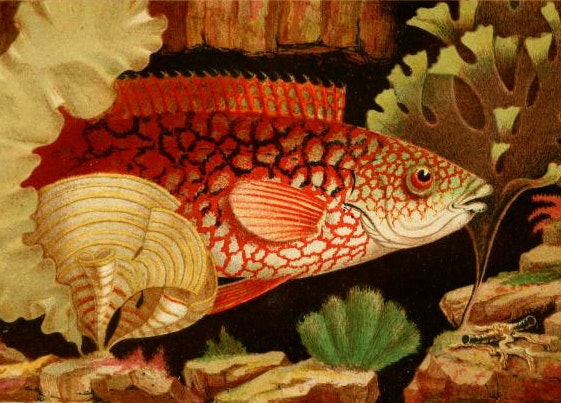 Scroll through the whole page to download all images before printing.
Scroll through the whole page to download all images before printing.“The Ancient Wrasse”, a detail from the frontispiece to The Aquarium (1856, 2nd edition) — Source.
The popularization of observing the interaction between marine animals and aquatic plants in glass tanks can be attributed to the Englishman Philip Henry Gosse, who was the first person to resolutely use the word “aquarium” for such objects. In his 1853 book A Naturalist’s Rambles on the Devonshire Coast, the term “vivarium” was used interchangeably with “marine aquarium”, but one year later the die was cast for the latter variant in his book The Aquarium: An Unveiling of the Wonders of the Deep Sea. As Gosse stated in its pages, the word should be “neat, easily pronounced and easily remembered”.1 The term “vivarium” was designated for tanks containing mainly snakes and amphibians; “aqua vivarium” was a step in the right direction, but the term was not yet perfect. Gosse understood “aquarium” as the neutral form of “aquarius”. He must also have known that to the ancient Romans an aquarium signified only a reservoir of water and that botanists had already been using this term for plant tanks for quite some time. For him this was not contradictory, but a justifiable linguistic expansion. He affirmed ceremoniously:
Let the word AQUARIUM then be the one selected to indicate these interesting collections of aquatic animals and plants, distinguishing it as Freshwater Aquarium, if the contents be fluviatile, or a Marine Aquarium, if [the contents are salt water-based].2
Gosse was born in 1810 in Poole in the south of England, the son of an impoverished travelling miniature painter. As a young man Gosse made his way across the Atlantic to Newfoundland, where he dealt with seal and cod fleets in the Carbonear harbour. In his early twenties he bought a copy of the book Essays on the Microscope at an auction and thenceforth devoted himself wholeheartedly to collecting insects. For two years he documented every insect he could get hold of. Along with some of his friends, he decided to move to mainland Canada in hopes of establishing a rural commune and opening a museum of stuffed birds. After both ventures failed, Gosse returned to England, where he found work as a teacher in Hackney until he received an invitation from the Society for the Promotion of Christian Knowledge to write An Introduction to Zoology. His research for the book inspired him to write another, The Ocean, published in 1844, on the findings of the explorer Sir James Clark Ross, who since 1818 had travelled throughout the Pacific and Arctic discovering a wide variety of marine flora and fauna. The book was an unexpected success and Gosse’s newfound notoriety led to an invitation to Jamaica later that year — a trip financed by an avid seashell collector in return for specimens to add to his collection. Gosse’s time in the Caribbean gave birth to three further books, all successes, and the author established himself as an important voice among the publishing naturalists of the period.
Upon his return from Jamaica, Gosse became a devout Christian, a faith that would shape much of his subsequent work. Through his wife, Emily Bowes, he became involved with a sect called the Plymouth Brethren Movement. His life was dictated by the monotony of seemingly endless prayers. Reading novels and poems as well as going to the theatre or singing temporal songs was forbidden — even social contacts outside the brotherhood were not permitted. Gosse strongly believed that Jesus Christ would return to Earth before his own death, and, under this sense of urgency, he set about to work on several book projects, all of which dealt with life on the coast. Gosse could either be found sitting behind his desk or working outside, where, dressed in his black suit, he fervently poked around in the silt of the tidal shallows or — even during heavy surf — meticulously examined the waterholes in rocks for any living creature. He became an authority for everything connected to coastal fauna, and his frequent speeches in London were always met with acclaim and adoration.
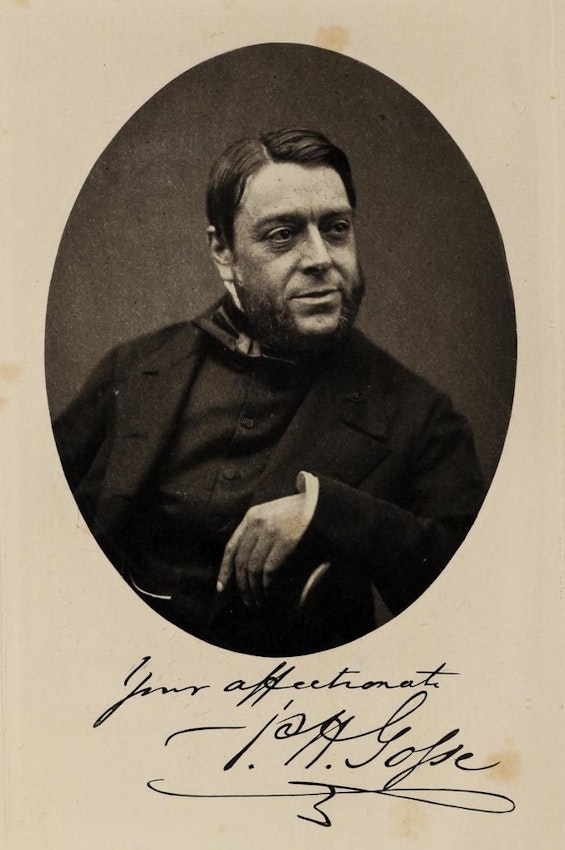 Scroll through the whole page to download all images before printing.
Scroll through the whole page to download all images before printing.Philip Henry Gosse as he appears in the frontispiece to The Naturalist of the Sea-shore: The Life of Philip Henry Gosse (1896) by his son Edmund — Source.
Of all Gosse’s works, the most successful was The Aquarium, in which he described his observations of coastal life and — a year after establishing the first public aquarium at the London Zoo — gave his readers instructions on how to build a miniature ocean of their very own. A saltwater aquarium, he asserted, was the perfect way to get acquainted with the peculiar creatures of the ocean without having to descend into the depths using complicated diving equipment. He was amused by a French zoologist, Henri Milne-Edwards, who stalked around at the bottom of the Mediterranean wearing a “water-tight dress, suitable spectacles, and a breathing tube” in order to take a closer look at the submarine world. All this was so much easier to achieve, Gosse proclaimed, in the safe environment of one’s own four walls.
In his many long-winded reports about his coastal excursions, Gosse told his readers that the aquarium was the objective, but that many obstacles still had to be overcome. One’s relation with nature required a cautious and respectful approach, for its exploration was, in Gosse’s mind, a spiritual exercise. For Gosse, religion and natural science went hand in hand: “it brings us, in some sense, into the presence of God”, he said, “or rather it gives us cognizance of Him, and reveals to us some of his essential attributes.”3 The aquarium was the perfect arena in which to witness the wondrous creations of Thomas Paley’s “Watchmaker God”. In A Naturalist’s Rambles, published the previous year, Gosse described how in the rock pools of the coast can be seen a glimpse of the prelapsarian bliss that reigned before the fall, and so also an insight into the state of nature that shall reign when Christ returns. In The Aquarium he went on to directly compare coral to the city of “heavenly Jerusalem”:
Is it fanciful to discern a faint shadow of these glories in a poor Polype? . . . When I look on the multitudes of Polypes inhabiting such a structure as I have alluded to, each bearing his starry crown, and all engaged in harmony, building up, wall by wall and cell by cell, an edifice whose walls are of crystalline clearness, often studded with what look like gems, and whose cells are closed with pearly doors ; if when I watch the building growing up into a City, a commonwealth, of myriad individuals ; when I know that, besides the separate life of each, there is a common life, a bond of identity, that constitutes the vast assemblage but one Being — One though Many — I cannot help thinking of the heavenly City, the Jerusalem which is above.4
As Jonathan Smith remarks in his Charles Darwin and Victorian Visual Culture, it is in light of such a vision that we must see the illustrations which populate Gosse’s books on coastal life. The mesmerising full-colour plates present “a sort of aquatic peaceable kingdom”, the scenes bustling with different species, all coexisting free from competition or want. The rock pools were pictured as having “the same qualities as the unfallen Garden of Eden . . . a visual glimpse of the millennial kingdom that awaits the true believer”.5
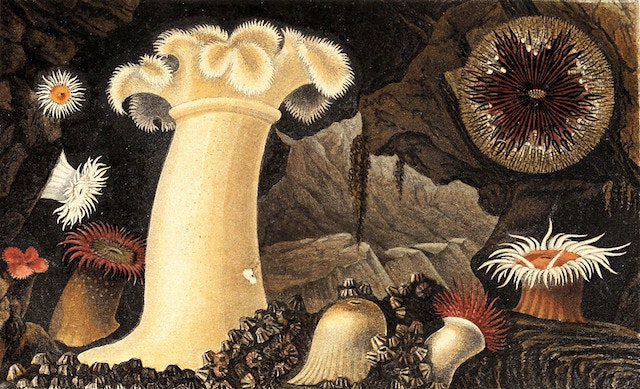 Scroll through the whole page to download all images before printing.
Scroll through the whole page to download all images before printing.Scene of Actinoloba in a lithographic print by William Dickes based on a drawing by Philip Henry Gosse, featured in Actinologia Britannica: A History of the British Sea-Anemones and Corals (1860) — Source.
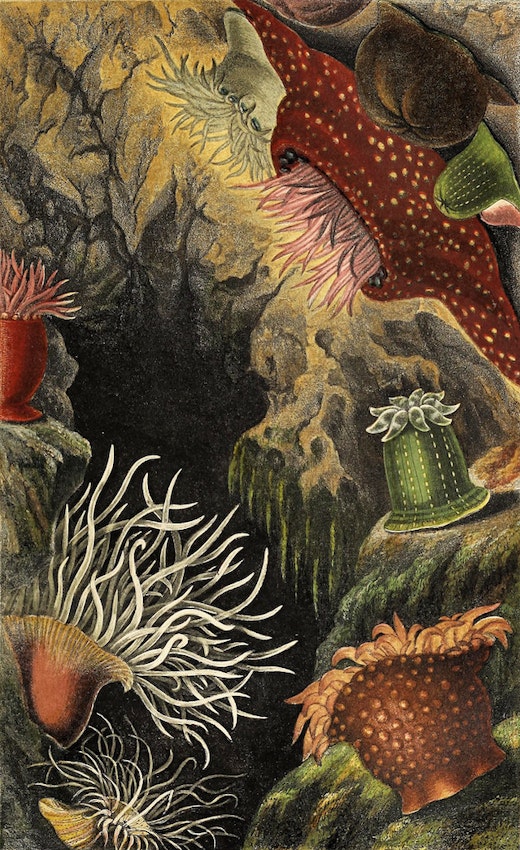 Scroll through the whole page to download all images before printing.
Scroll through the whole page to download all images before printing.Scene of Tealia, in a lithographic print by William Dickes based on a drawing by Philip Henry Gosse, featured in Actinologia Britannica: A History of the British Sea-Anemones and Corals (1860) — Source.
Gosse’s pioneer aquarium contained an impressive abundance of marine fauna and flora. Prior to finding the animals, it was important to gather the plants, which were responsible for the oxygen in the tank. For this, Gosse recommended the day after a full moon or new moon, as the tide is then as far out as possible and areas usually covered with water become visible. Armed with a covered collecting basket, stone and glass jars, two or three smaller vials, and some hammers and chisels, he ventured out to the ledges of rock at the edge of the sea. He was especially drawn to rough and sharp crevices — those which any intelligent hiker would try to avoid at all costs — because it was here that the desired plants tried to hide:
We lift up the hanging mass of olive weed (Fucus) from the edge, and find the sides of the clefts often fringed with the most delicate and lovely forms of sea-weed; such for example, as the winged Delesseria (D. alata), which grows in thin, much-cut leaves of the richest crimson hue, and the feathery Ptilota (P. plumosa) of a duller red. 6
The plant had to be removed together with a piece of the rock on which it grew; only this way did it have a chance of survival. After skilful chiselling (often under water), each piece of grass found its temporary home in a receptacle that had been brought along. It was even more important to have a suitable transport container handy when collecting animals. According to Gosse, a collector should always be watchful and alert, as strange creatures of various forms and shapes could appear at any moment.
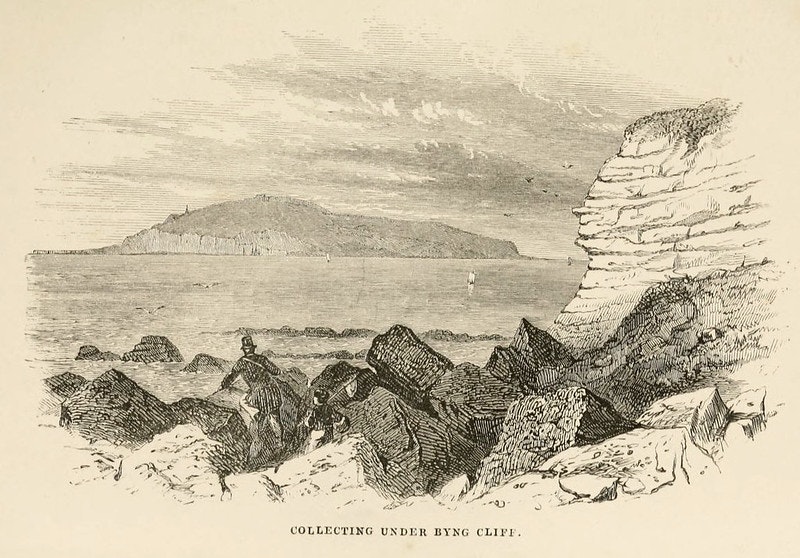 Scroll through the whole page to download all images before printing.
Scroll through the whole page to download all images before printing.Illustration featured in The Aquarium (1856, 2nd edition). This area of coast (thought to correspond to what is now called Newton’s Cove, near Weymouth in Dorset) was a fertile hunting ground for Gosse, and where he came across the rare jellyfish “Goblet Lucemaria” (Depastrum cyathiforme) — Source.
Upon returning from his seaside excursion, Gosse would begin the process of transferring his findings from the temporary tanks into his marine aquarium. The exterior of Gosse’s aquarium already resembled the familiar rectangular glass tank with birchwood beading. It was 61 × 30 × 30 cm (2 × 1 × 1 ft); the sides and ends were panes of glass and the bottom was slate. The panes were puttied between the birchwood, which was a tremendous improvement over earlier prototypical aquariums, as the even glass surfaces did not cause the optical distortions that round glass did. Gosse covered the bottom of the aquarium with an insulating layer of clay, pebbles, sand, and, finally, small pieces of rock, which formed mini-bridges and overhangs that gave the swimming creatures shelter. After adding the plants, Gosse poured 76 litres (20 gallons) of salt water over the miniature landscape. During the first night, Gosse would observe the tank by candlelight and see that numerous tiny shells and micro-organisms were already bustling around inside.
The animals were added the following day. Among the specimens were one 15-spined stickleback, seven grey mullet, one black goby, three common periwinkles, one anomia, two common cockles, two ascidia, two hermit crabs, four sand shrimp, one prawn, three crown worms, two thick-horned anemones, and many others. All in all, around one hundred animals found a new home in the tank. Although the tank could handle even more, and two or three gallons of saltwater per day were constantly dripping into the aquarium from another vessel suspended over the tank as “artificial aeration”, it dawned on Gosse that the consumption of oxygen would soon exceed its supply. The first week of his experiment proved to be successful (apart from one or two attacks on weaker animals by predatory species). But three days into the second week a number of animals died, and the water developed an unpleasant smell from those that had died in the sanctuary of the stones. After thoroughly cleaning the tank, Gosse carried on his experiment with the remaining fauna and flora.
Since there was as yet little possibility for the general populace to experience many of the creatures Gosse and others had collected, it fell to Gosse to bring them to life on the pages of his books. In his descriptions he concentrated on those animals that best embodied the mystery of the submarine world. He repeatedly used analogies to land animals — combining human and animal forms to create clear pictures in the readers’ minds. Gosse referred to one creature, with its long silky hair adorning it like a fur coat, as the “sea mouse”, which he called “the most gorgeously clad of all the creatures that inhabit the deep”.7 Linnaeus, the great taxonomist of biology, who established a new system for naming, ranking, and classifying organisms, had referred to it as “Aphrodite” as early as the eighteenth century. According to Gosse, the “Aphrodite aculata, reflecting the sun-beams from the depths of the sea, exhibits as vivid colours as the peacock itself, spreading its jewelled train”.8 In the aquarium the sea mouse attracts attention due to its restless movements and a jet of water that spurts every twenty-four seconds. The splendour of its changing colours made it an object of admiration: red and orange reflections usually appeared under candlelight, while during the day they changed to green and blue. Gosse also adored prawns, which he considered “particularly pleasing inhabitants of the aquarium”:
There is a certain lightness in the slender filiform appendages of the head, which are continually thrown into the most graceful curves, that resembles in character ‘the light tracery of ropes and spars’ so much admired in a trimly rigged ship. Their bodies are so pellucid that a lady who was this moment looking at the tank compared them to ghosts, and their smooth gliding movements aid the similitude.9
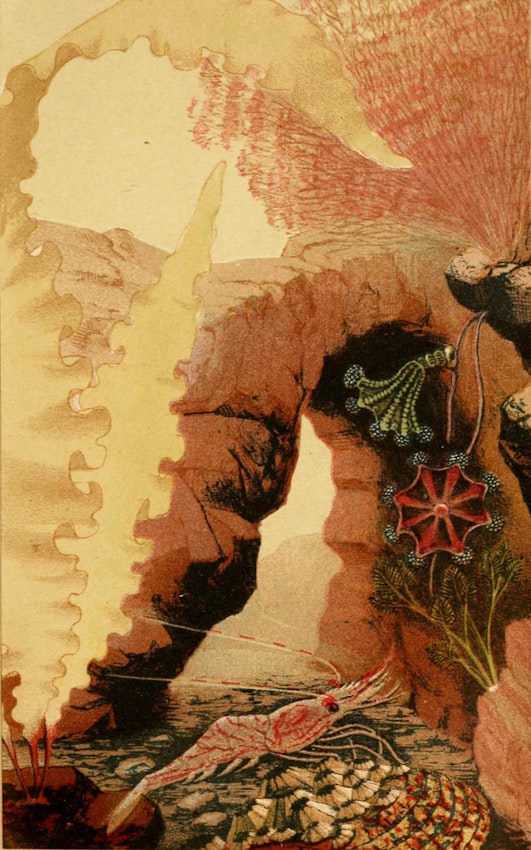 Scroll through the whole page to download all images before printing.
Scroll through the whole page to download all images before printing.“The Aesop Prawn”, from The Aquarium (1856, 2nd edition) — Source.
The submarine world is a place where definitions are loose — the alter ego of our world on dry land. Coral, starfish, anemone, jellyfish, sea horse: are they mineral or animal, living or dead, fauna or flora, male or female? Gosse was particularly fascinated by those creatures that build some sort of relationship but can hardly be differentiated as individuals. The alliance between whelks, hermit crabs, and sea anemones is, in Gosse’s view, simply brilliant:
Many persons who know a Whelk as well as possible, hesitate when they see the familiar shell tenanted, not by the great black-spotted Mollusk, but by a mongrel between Crab and Lobster, with stout, red, pinching claws, and long, jointed, and pointed legs. And still more mysterious does the thing look, when two thirds of the shell itself is enclosed in a thick mass of purple-spotted flesh, through the midst of which the busy Crab his poking his head and limbs. In truth it is a strange affair, this threefold alliance of Whelk, Hermit-crab, and Cloak-anemone.10
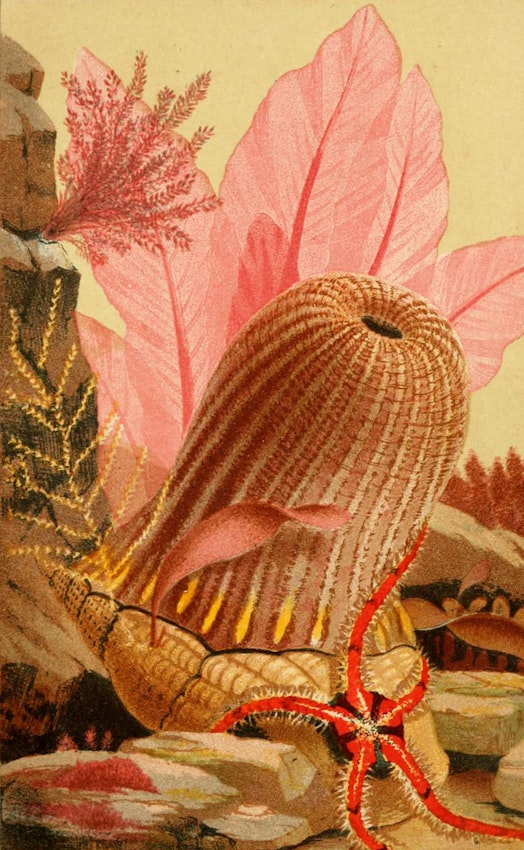 Scroll through the whole page to download all images before printing.
Scroll through the whole page to download all images before printing.“Parasitic Anemone”, from The Aquarium (1856, 2nd edition) — Source.
In fact it is a relationship between only two living creatures, because just the whelk’s shell remains, no longer inhabited by the original mollusc. Gosse defined crabs as “the scavengers of the sea” which, like wolves and hyenas, devour everything alive or dead.11 The sea anemone — also known as the animal flower, polyp, or by its scientific name, Actinia — with its colour-changing tentacles, can often be found sitting on stones on the ocean bed, expanding to great lengths before shrinking to a tenth of its size. Equally fascinating, pieces of the creature could break away and develop into new animals. Due to its flower-like appearance, the sea anemone was for a long time mistakenly considered to be the “missing link” between plants and animals.
The symbiosis of hermit crab and sea anemone is — according to Gosse — open to all possible speculation and interpretation. Who is actually in control? Is it the crab, pulling the anemone along the ocean bed, striking it with scattered stones? Or has the sea anemone devoured the shell together with the crab, and has the crab then managed to find a way out through the stomach and skin of the sea anemone? Has the sea anemone released a special membrane which, while allowing the crab a suitable home, prevents it from ever leaving? With the help of the aquarium, Gosse hoped to discover the principle of their opposite attraction and the secret of the apparent melding of bodies and identities.
However, it was not until the 1920s and 30s that biologists were able to offer plausible explanations for this interaction, which is now regarded as a prime example of biological symbiosis. Sea anemones use their nematocysts to keep octopuses away from the crab and in return are able to gain a much bigger habitat due to the host’s movements. Additionally, the sea anemone can ingest some of the crab’s prey as its mouth directly faces the masticatory organs of the crab. This relationship can, however, end in tragedy: if the hermit crab cannot find enough food, it will eat the sea anemone.
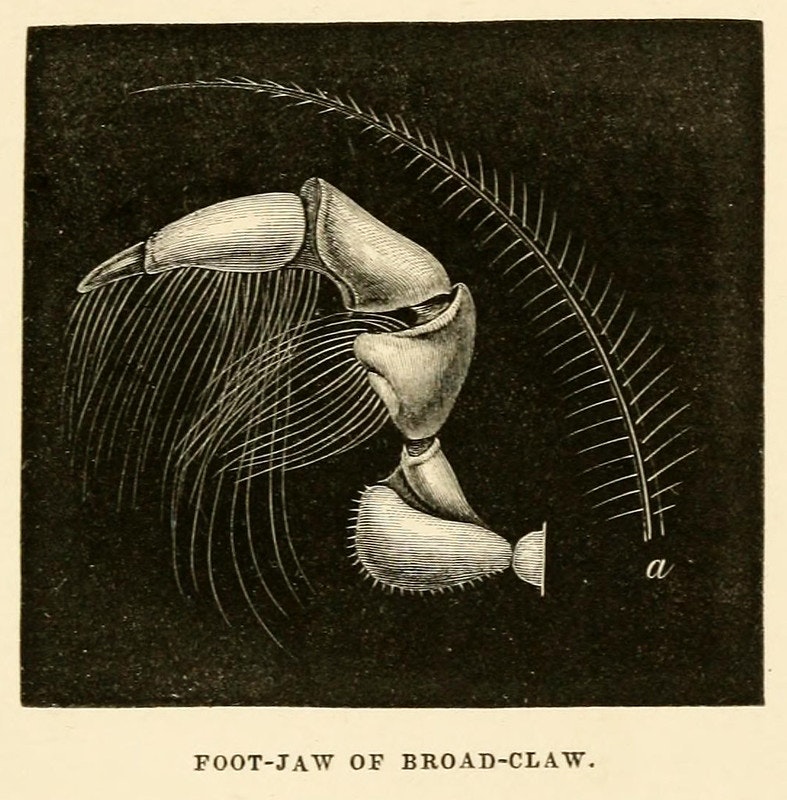 Scroll through the whole page to download all images before printing.
Scroll through the whole page to download all images before printing.Illustration featured in The Aquarium (1856, 2nd edition) — Source.
For Gosse the aquarium was a living museum, a curious inversion of Noah’s Ark — all species of marine fauna and flora, safely held amidst a dry environment. Comparable to the zoological gardens that brought the animal kingdom to cities or the botanical garden hothouses that showcased tropical flora — living compendiums through which nature lovers and flâneurs alike could wander — the aquarium encapsulated the submarine world into a “see-through” form, the paradox of an ocean journey within one’s own home.
Gosse had a way of expressing his enthusiasm in his books and articles that positively stirred the bourgeoisie. His numerous lectures on oceanic subjects always caused a sensation. According to the Literary Gazette, a Victorian magazine published in London, Gosse had “dived into all those decorated palaces which had unassertively been kept under lock and key by old Neptune for such a long time”;12 another chronicler wrote that “all the world wanted to possess an aquarium to verify his assertions and repeat his experiments”;13 the magazine Blackwoods even recommended that children should not see the book, otherwise there would be no peace and quiet in the house until the children were finally allowed to have an aquarium. But the burgeoning fad needed more than Gosse’s contagious enthusiasm to be a success: it also had to please the eye.
High-quality illustrations, which were quite rare at the time, played an important role in the success of most of Gosse’s books. He had inherited his father’s artistic talents and is credited with providing the drawings for many of the beautiful lithographic plates that accompany his texts. According to the scholar Barbara T. Gates, it was, however, his wife Emily — a talented artist trained by popular landscape painter John Sell Cotman — who made the drawings for the stunning plates found in The Aquarium.14 Although her images proved so integral to the book’s popularity, she is entirely uncredited on its pages, her husband’s name inscribed below the images instead. While it was general convention at the time for picture credits in scientific publications to default to the text’s author, one does wonder why Henry failed to mention his wife’s contribution at all in his preface, despite finding room to acknowledge the lithograph printers.
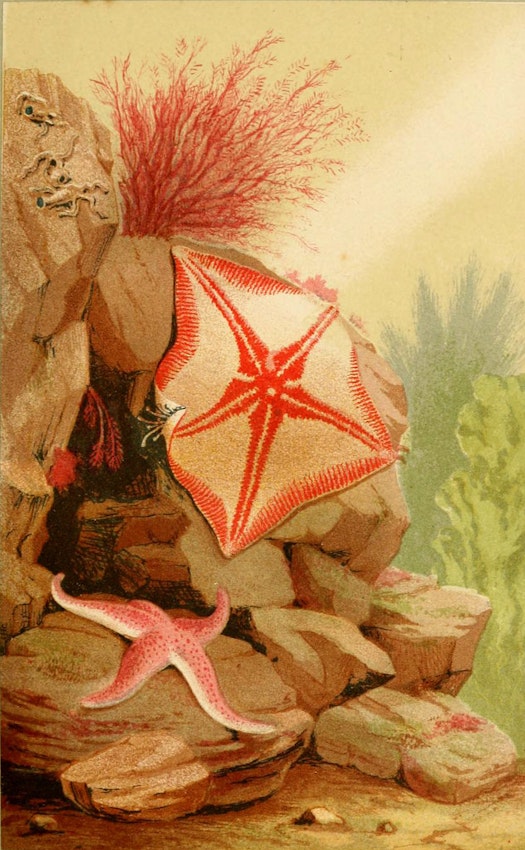 Scroll through the whole page to download all images before printing.
Scroll through the whole page to download all images before printing.“Starfish”, from The Aquarium (1856, 2nd edition) — Source.
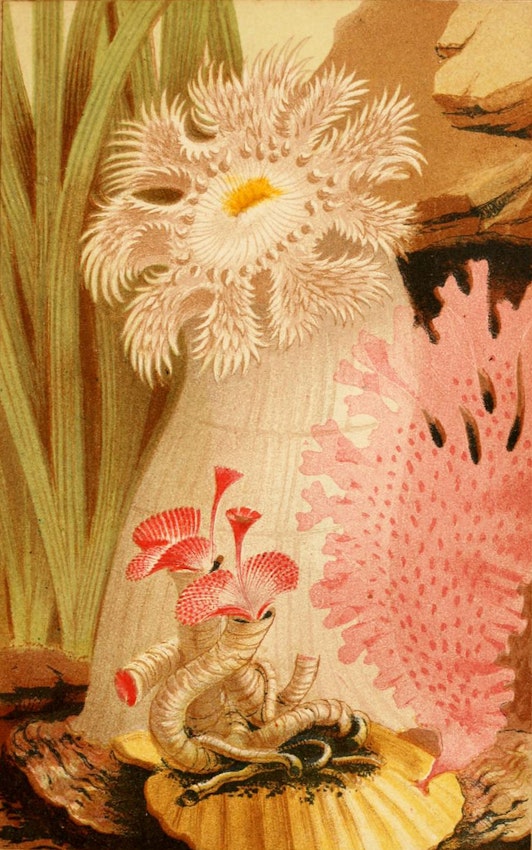 Scroll through the whole page to download all images before printing.
Scroll through the whole page to download all images before printing.“Plumose Anemone”, from The Aquarium (1856, 2nd edition) — Source.
The Aquarium was more than a cultural sensation: it was also a financial success, with earnings of about £805 (roughly £40,000 today). A year later, a smaller Handbook to the Marine Aquarium was published for those who had not been able to afford the first book. From the collecting of ferns, the Victorian bourgeoisie now turned their attention toward the exploitation of the coastal regions. The rapidly expanding middle class found this new fad a topic suitable for conversation as well as education. As Henry D. Butler retrospectively wrote about the British aquarium mania in his book The Family Aquarium — “The aquarium was on everybody’s lip. The aquarium rang in every body’s ear. Morning, noon, and night, it was nothing but the aquarium.”15
A shop on Portland Road in London, owned by William Alford Lloyd, established itself at the beating heart of the fad. Fifty large tanks and countless smaller containers held some 15,000 marine specimens. The emporium sold salt water over the counter by the pint, quart, or gallon. Aquariums were manufactured in a nearby factory, and Lloyd employed more than a dozen people for the purpose of collecting plants and animals from the coasts and purchasing lots from amateur collectors. Before the existence of Lloyd’s shop, people had to make excursions out to the coast, and transportation was often expensive and dangerous, which made the whole undertaking quite unappealing. Once Lloyd went into business, aquarium lovers could obtain everything they needed easily and frequently.
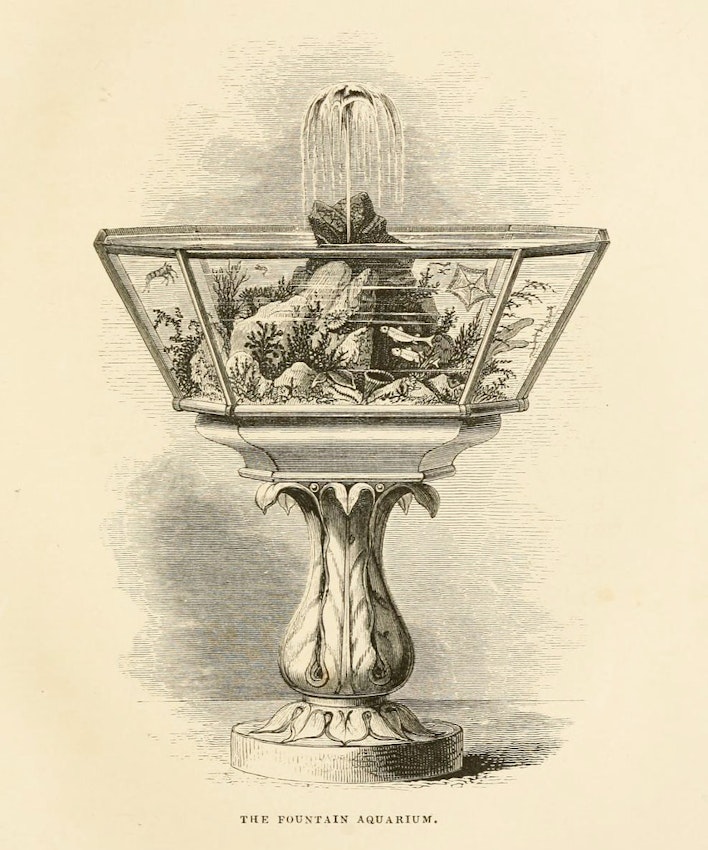 Scroll through the whole page to download all images before printing.
Scroll through the whole page to download all images before printing.Illustration featured in The Aquarium (1856, 2nd edition) — Source.
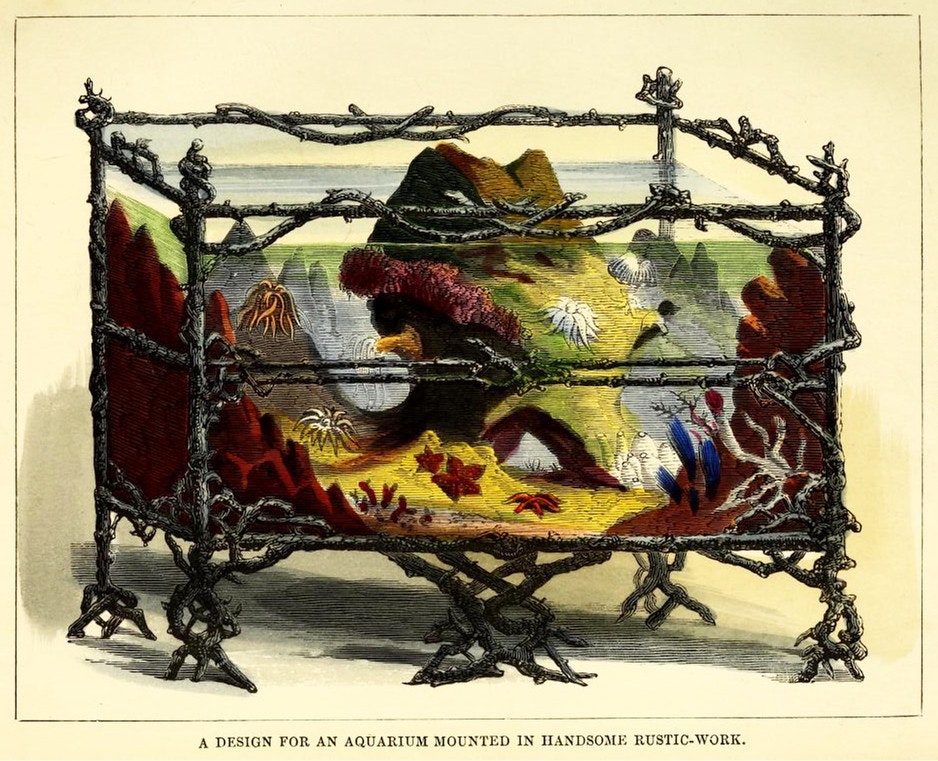 Scroll through the whole page to download all images before printing.
Scroll through the whole page to download all images before printing.Illustration featured in Ocean Gardens: The History of the Marine Aquarium (1857) by Henry Noel Humphreys — Source.
The aquarium craze of the 1850s, however, was just that: a craze. According to the British social historian David Elliston Allen in his fascinating study The Naturalist in Britain, the wave of nature enthusiasm in the 1850s was “sloppier, less intelligent, more given to hysteria” than in the preceding decades.16 Only a few years later, “aquarium mania” was already a thing of the past, at least in Britain. Nine out of ten aquariums had been either dumped or simply left to their own devices. The individual experience of the parlour gave way to the collective experience of the large public aquariums found in Brighton and other coastal resorts.
Though short, the intensity of this aquarium fad was sadly not without its environmental cost. Along the coastline the hunt for plants and animals caused real devastation, and by the beginning of the twentieth century the coastal landscape had completely changed. James Hamilton-Paterson in Seven-Tenths explicitly holds “zoology allied to a strong religious bent” responsible for this development.17 In 1907, Gosse’s son Edmund — in contrast to his father, a convinced Darwinist — put matters straight in his memoir Father and Son:
The ring of living beauty drawn about our shores was a very thin and fragile one. It had existed all those centuries solely in consequence of the indifference, the blissful ignorance of man. These rock-basins, fringed by corallines, filled with still water almost as pellucid as the upper air itself, thronged with beautiful sensitive forms of life – they exist no longer, they are all profaned, and emptied, and vulgarised. An army of ‘collectors’ has passed over them, and ravaged every corner of them. The fairy paradise has been violated, the exquisite product of centuries of natural selection has been crushed under the rough paw of well-meaning, idle-minded curiosity. That my father, himself so reverent, so conservative, had by the popularity of his books acquired the direct responsibility for a calamity that he had never anticipated, became clear enough to himself before many years had passed, and cost him great chagrin.18
Bernd Brunner writes at the crossroads of culture, history, and science, and is the author of, among others, Birdmania: A Remarkable Passion for Birds (Greystone Books, Allen & Unwin), Bears: A Brief History (Yale University Press), and The Ocean at Home: An Illustrated History of the Aquarium (Reaktion Books). Website: www.berndbrunner.com





